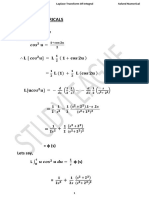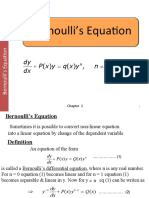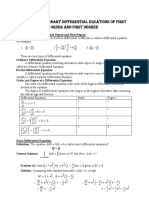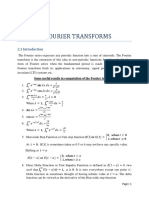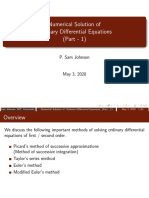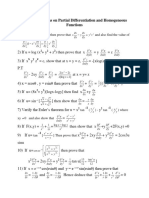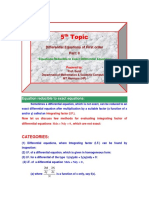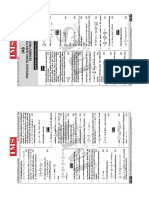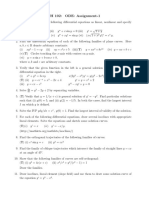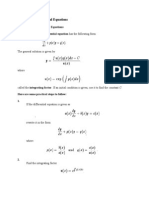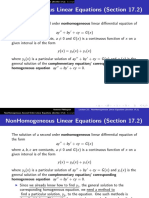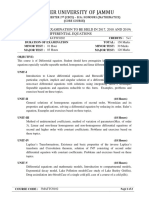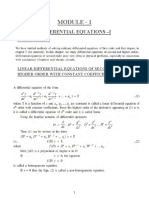Solutions to Problem Numbers 8 and 33
Francis Fellippe Amor S. Gumahin
FINAL TERM: August 2020
Problem No. 8:
Solve the differential equation using MUC
4y00 − 4y0 − 3y = cos(2x ). (1)
SOLUTION:
We solve for the homogeneous solution of the equation by writing its characteristic equation and solving
for its roots
4λ2 − 4λ − 3 = 0
� �
3 1
λ= ,−
2 2
Since the characteristic equation has distinct roots, the homogeneous solution takes on case no. 1:
3 1
y h = c1 e 2 x + c2 e − 2 x
3 1
y1 = e 2 x y2 = e − 2 x
Now, we solve for the partial solution y p . Since φ( x ) = cos(2x ), it takes on case no. 3, such that k1 = 0,
k2 = 1, and β = 2. We write the assumed equation as
y p = A sin(2x ) + B cos(2x ).
We solve for the constants by simultaneously solving the following system of equations
y p = A sin(2x ) + B cos(2x ) (2)
y0p = 2A cos(2x ) − 2B sin(2x ) (3)
y00p = −4A sin(2x ) − 4B cos(2x ) (4)
We plug equation numbers (2-4) to (1) then simplify
−4(−4A sin(2x ) − 4B cos(2x )) − 4(2A cos(2x ) − 2B sin(2x )) − 3( A sin(2x ) + B cos(2x )) = cos(2x )
−19A sin(2x ) − 19B cos(2x ) − 8A cos(2x ) + 8B sin(2x ) = cos(2x )
(19A + 6B) sin(2x ) + (−19 − 8A) cos(2x ) = cos(2x )
Solving for A and B yields
− 19A + 8B = 0 −19B − 8A = 1
� �
8 8
A= B −19B − 8 B=1
19 19
425
− B=1
19
19
B=−
425
8
⇒A=−
425
1
�Substituting the computed coefficients A and B to equation (2), we write the particular solution
8 19
yp = − sin(2x ) − cos(2x ).
425 425
We know that the general solution y( x ) = yh + y p ; thus the general solution is
3 1 8 19
y ( x ) = c1 e 2 x + c2 e − 2 x − sin(2x ) − cos(2x )
425 425
Problem No. 33:
Solve the differential equation using MUC
d2 x
= ω 2 t = F0 sin(ωt)
dt2
x 00 + ω 2 t = F0 sin(ωt)
x (0) = 0 x 0 (0) = 0
To solve for homogeneous equation we write the characteristic equation of the differential equation
and solve for roots
λ2 + ω 2 = 0
λ1 = iω
λ2 = −iω
The homogeneous equation is
xh = c1 cos(ωt) + c2 sin(ωt)
We see that φ( x ) takes on the form of case no. 3; such that k1 = F0 , k2 = 0, and β = ω, thus, we write the
assumed equation of the particular equation as x p = A sin(ωt) + B cos(ωt). Since x p = yh , we multiply
the particular equation with the factor x m such that m = 1. We get the particular equation
x p = At sin(ωt) + Bt cos(ωt)
We solve for the coefficients A and B by simultaneously solving the following system of equations
x p = At sin(ωt) + Bt cos(ωt)
x 0p = A sin(ωt) + Aωt cos(ωt) + B cos(ωt) − Bωt sin(ωt)
x 00p = 2A cos(ωt) − Aω 2 t sin(ωt) − 2B sin(ωt) − Bω 2 t cos(ωt)
By plugging x 00p and x p to the given problem equation, we get
2A cos(ωt) − Aω 2 t sin(ωt) − 2Bω sin(ωt) − Bω 2 t cos(ωt) + ω 2 ( At sin(ωt) + Bt cos(ωt)) = F0 sin(ωt).
After simplifying,we solve for coefficients A and B.
(2A)cos(ωt) + (−2B)ω sin(ωt) = F0 sin(ωt)
2A = 0 −2B = F0
1
A=0 B = − F0
2
Substituting the computed A and B to y p , we get
1
y p = − F0 t cos(ωt)
2
2
�Now we have the general solution
1
x (t) = c1 cos(ωt) + c2 sin(ωt) − F0 t cos(ωt)
2
Using the initial conditions x (o ) = 0 and x 0 (0) = 0, we are able to solve for the c1 and c2 . Giving us:
1
x (0) = c1 cos(0) + c2 sin(0) − F0 (0) cos(0) = 0
2
⇒ c1 = 0
1 1
x 0 (t) = −ωc1 sin(ωt) + c2 ω cos(ωt) − F0 cos(ωt) − F0 ω sin(ωt)
2 2
1 1
x 0 (0) = −ωc1 sin(0) + c2 ω cos(0) − F0 cos(0) − F0 ω sin(0) = 0
2 2
1
⇒ c2 = F0
2ω
Finally, we have the general equation
F0
x (t) = [sin(ωt) − ωt cos(ωt)] .
2ω








